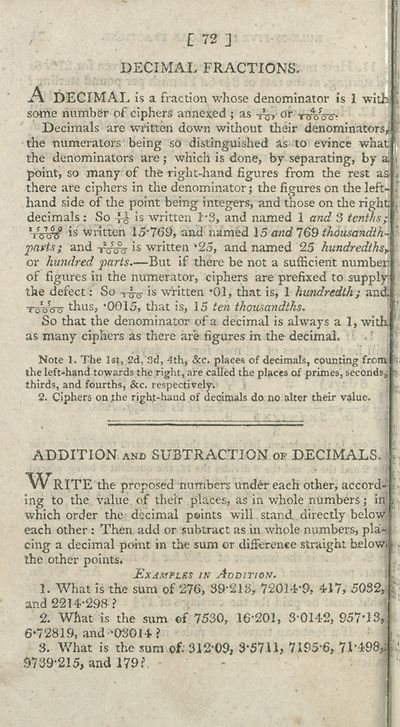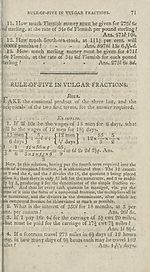Download files
Complete book:
Individual page:
Thumbnail gallery: Grid view | List view

[ 72 ]
DECIMAL FRACTIONS.
A DECIMAL is a fraction whose denominator is 1 with
some number of ciphers annexed ; as tV, or ttoW
Decimals are •written down without their denominators^
the numerators being sb distinguished as to evince what
the denominators are; which is done, by separating, by ai
point, so many of the right-hand figures from the rest as
there are ciphers in the denominator; the figures on the left-
hand side of the point being integers, and those on the right
decimals: So 44 >s written T3, and named 1 and 3 tenths A ■
is written 15'769, and named 15 and 769 thousandth- '
parts; and tVo9# is written ‘25, and named 25 hundredths,
or hundred parts.—But if there be not a sufficient number
of figures in the numerator, ciphers are prefixed to supply?
the defect: So t4o is written ‘01, that is, 1 hundredth; and
-roVcre thus, -0015, tliat is, 15 ten thousandths.
So that the denominator of a decimal is always a 1, with ,
as many ciphers as there are figures in the decimal.
Note 1. The 1st, 2d, 3d, 4th, &c. places of decimals, counting from- >:
the left-hand towards the right, are called the places of primes, seconds^ '
thirds, and fourths, &c. respectively.
2. Ciphers on the right-hand of decimals do no alter their value.
ADDITION, and SUBTRACTION of DECIMALS, i!
WRITE the proposed numbers under each other, accord-*
ing to the value of their places, as in whole numbers; in*!
which order the; decimal points will stand directly below*
each other: Then add or subtract as in whole numbers, plan
cing a decimal point in the sum or difference straight below -
the other points. ' ,
Examples in Addition.
1. What is the sum of 276, 39-218, 72014-9, 417, 5032,1 •
and 2214-29S?
2. What is the sum ©f 7530, 16-201, 3-0142, 957-13,
6-72819, and -03014 i
3. What is the sum of: 312-09, 3-5711, 7195-6, 7T493, '
9739-215, and 179?
DECIMAL FRACTIONS.
A DECIMAL is a fraction whose denominator is 1 with
some number of ciphers annexed ; as tV, or ttoW
Decimals are •written down without their denominators^
the numerators being sb distinguished as to evince what
the denominators are; which is done, by separating, by ai
point, so many of the right-hand figures from the rest as
there are ciphers in the denominator; the figures on the left-
hand side of the point being integers, and those on the right
decimals: So 44 >s written T3, and named 1 and 3 tenths A ■
is written 15'769, and named 15 and 769 thousandth- '
parts; and tVo9# is written ‘25, and named 25 hundredths,
or hundred parts.—But if there be not a sufficient number
of figures in the numerator, ciphers are prefixed to supply?
the defect: So t4o is written ‘01, that is, 1 hundredth; and
-roVcre thus, -0015, tliat is, 15 ten thousandths.
So that the denominator of a decimal is always a 1, with ,
as many ciphers as there are figures in the decimal.
Note 1. The 1st, 2d, 3d, 4th, &c. places of decimals, counting from- >:
the left-hand towards the right, are called the places of primes, seconds^ '
thirds, and fourths, &c. respectively.
2. Ciphers on the right-hand of decimals do no alter their value.
ADDITION, and SUBTRACTION of DECIMALS, i!
WRITE the proposed numbers under each other, accord-*
ing to the value of their places, as in whole numbers; in*!
which order the; decimal points will stand directly below*
each other: Then add or subtract as in whole numbers, plan
cing a decimal point in the sum or difference straight below -
the other points. ' ,
Examples in Addition.
1. What is the sum of 276, 39-218, 72014-9, 417, 5032,1 •
and 2214-29S?
2. What is the sum ©f 7530, 16-201, 3-0142, 957-13,
6-72819, and -03014 i
3. What is the sum of: 312-09, 3-5711, 7195-6, 7T493, '
9739-215, and 179?
Set display mode to:
![]() Universal Viewer |
Universal Viewer | ![]() Mirador |
Large image | Transcription
Mirador |
Large image | Transcription
| Antiquarian books of Scotland > Education > Complete treatise on practical arithmetic and book-keeping > (86) |
|---|
| Permanent URL | https://digital.nls.uk/114434602 |
|---|
| Description | Thousands of printed books from the Antiquarian Books of Scotland collection which dates from 1641 to the 1980s. The collection consists of 14,800 books which were published in Scotland or have a Scottish connection, e.g. through the author, printer or owner. Subjects covered include sport, education, diseases, adventure, occupations, Jacobites, politics and religion. Among the 29 languages represented are English, Gaelic, Italian, French, Russian and Swedish. |
|---|

